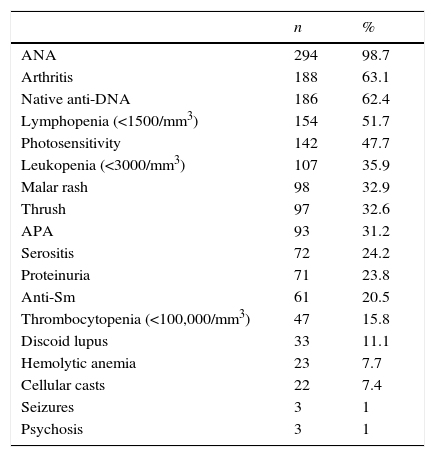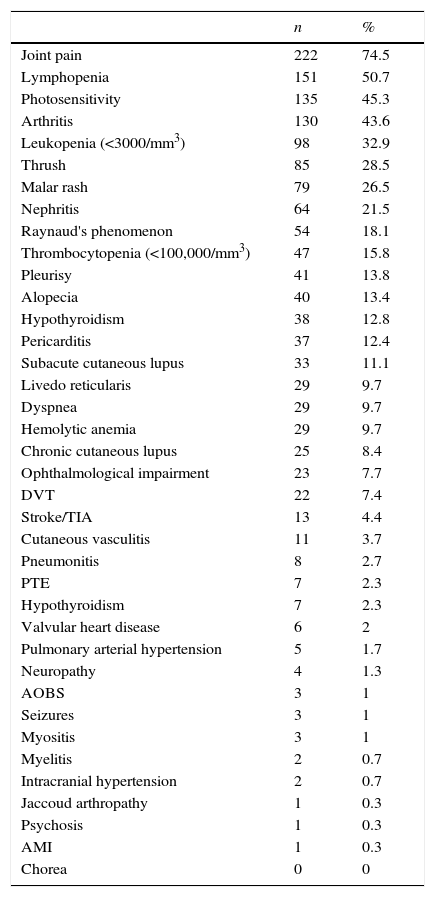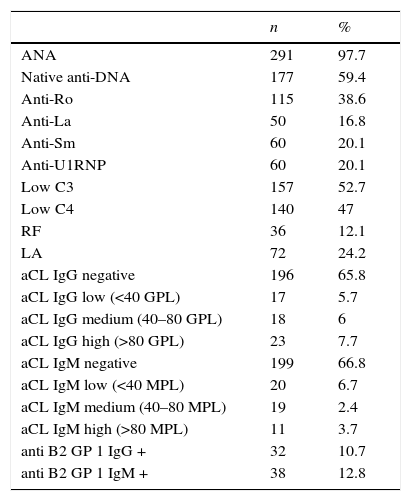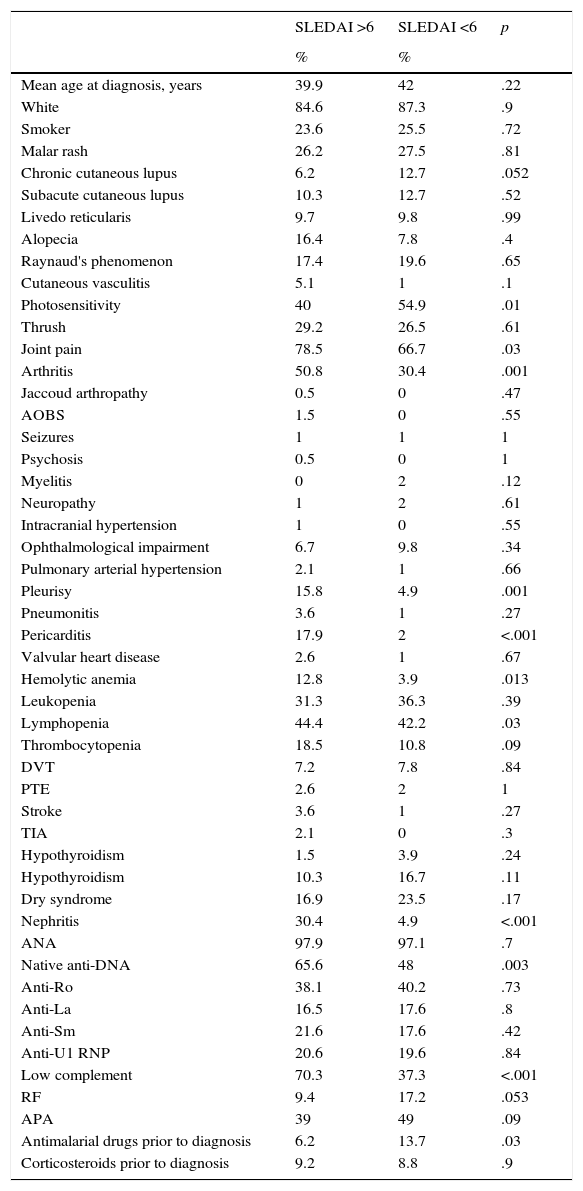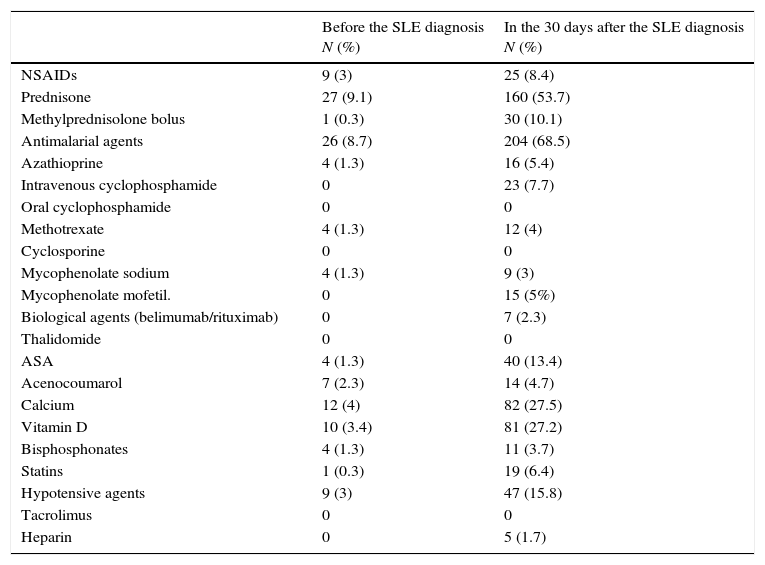Patient registries are useful tools for assessing rare diseases. Our objective is to present the Spanish registry of patients with systemic lupus erythematosus (Registro español de pacientes con lupus eritematoso sistémico, RELES).
Patients and methodsRELES was started in 2008 as an observational, prospective, multicentre cohort registry that included patients from the time they were diagnosed. The registry's objective is to analyse the incidence and noninflammatory complications of systemic lupus erythematosus (SLE). The departments of internal medicine of 38 Spanish hospitals participate in this registry.
ResultsA total of 298 patients with a mean age of 40.8±15.7 years were included, 88.9% of whom were women and 85.6% of whom were white. In the first visit, there was a predominance of joint manifestations (74.5%). One hundred and seventy-seven patients (59.4%) were positive for anti-native DNA. In these patients, there was a higher rate of lupus nephritis (26.7% vs. 14%, p=.009; relative risk [RR], 1.33), haemolytic anaemia (13.6% vs. 4.1%, p=.07; RR, 1.46) and lymphopenia (55.4% vs. 43.8%, p=.05; RR, 1.21). The median Systemic Lupus Erythematosus Disease Activity Index 2000 (SLEDAI 2K) score was 9.64 points (interquartile range, 4–13). The patients treated with antimalarial drugs before the diagnosis of SLE had a median SLEDAI score in the first visit of 5, compared with 8 for those who were not treated with these drugs (p=.02).
ConclusionsRELES constitutes the first Spanish patient cohort with SLE recorded from the time of the diagnosis. The presence of anti-DNA has been related to severe manifestations such as nephritis and haemolytic anaemia. Treatment with antimalarial drugs before the diagnosis was associated with less active disease at the initial presentation.
Los registros de pacientes son herramientas útiles para evaluar enfermedades poco frecuentes. Nuestro objetivo es presentar el «Registro español de pacientes con lupus eritematoso sistémico» (RELES).
Pacientes y métodosRELES se inició en 2008, como un registro multicéntrico de cohortes, observacional, prospectivo, incluyendo a pacientes desde el momento del diagnóstico, cuyo objetivo es analizar la incidencia y complicaciones no inflamatorias del lupus eritematoso sistémico (LES). Participan los servicios de Medicina Interna de 38 hospitales españoles.
ResultadosSe incluyó a 298 pacientes con una edad media de 40,8±15,7 años, de los que el 88,9% eran mujeres y el 85,6% de raza caucásica. En la primera visita, predominaron las manifestaciones articulares (74,5%). Ciento setenta y siete pacientes (59,4%) mostraban positividad para anti-DNA nativo, siendo superior en estos la frecuencia de nefritis lúpica (26,7% vs. 14%, p=0,009; riesgo relativo [RR] 1,33), de anemia hemolítica (13,6% vs. 4,1%, p=0,07; RR 1,46) y linfopenia (55,4% vs. 43,8%, p=0,05; RR 1,21). La mediana del Systemic Lupus Erythematosus Disease Activity Index 2000 (SLEDAI 2K) fue de 9,64 puntos (rango intercuartílico 4-13). Los tratados con antipalúdicos antes del diagnóstico de LES tenían una mediana de SLEDAI en la primera visita de 5, frente a 8 en los que no los tomaban (p=0,02).
ConclusionesRELES constituye la primera cohorte de pacientes con LES recogidos desde el momento del diagnóstico en España. La presencia de anti-DNA se ha relacionado con manifestaciones graves como nefritis y anemia hemolítica. El tratamiento con antipalúdicos antes del diagnóstico se asoció con una enfermedad menos activa al comienzo.
Article
Diríjase desde aquí a la web de la >>>FESEMI<<< e inicie sesión mediante el formulario que se encuentra en la barra superior, pulsando sobre el candado.

Una vez autentificado, en la misma web de FESEMI, en el menú superior, elija la opción deseada.

>>>FESEMI<<<



